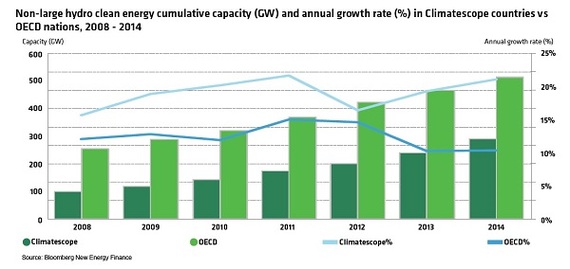By Michael Hofmann and David Bloomgarden

Michael Hofmann is a green growth expert at the Multilateral Investment Fund who works at the intersection of the public and private sectors on the issues of innovative climate change and corporate sustainability business models, value chains, regulatory mechanisms, and financial instruments.
With climate change an increasing concern, clean energy technologies are an attractive alternative. What's more, development of these new, low-carbon technologies--including biomass, geothermal, hydro, solar, and wind--can help reduce poverty in developing countries and enhance their energy security.
In this context, a new report has some encouraging news: new investment in clean power generation in 2014 increased in 55 countries in Latin American and the Caribbean, Africa and Asia, to an annual record of $126 billion--up by almost 40% from 2013 levels. Furthermore, for the first time, more than half of total new investment in clean energy globally went into projects in emerging markets, according to Climatescope 2015.
Climatescope, a clean energy country competitiveness index covering 55 countries, provides data about investment (the availability and cost of local financing) and three additional areas that support the development of clean energy projects: regulations (local policies and the structure of the local energy sector); value chains (the availability of local goods and services); and activity to reduce emissions of greenhouse gases.
Brazil, Chile, South Africa, and India, which rank 2-5 in the global index, have seen significant clean energy activity and investment. However, their performance is dwarfed by that of the top country, China, which accounted for 35 gigawatts (GW) of the total 50 GW of new clean energy capacity built in the 55 Climatescope countries in 2014.
Rich natural resources, declining costs help spur growth
On a regional level, Latin America and the Caribbean has seen remarkable clean energy growth. In the last three years, the clean energy capacity installed in the region--other than large hydro power plants--has almost doubled, to 39 GW from 23 GW. That new number represents 11% of the total 352 GW of power generation capacity in the region at the end of 2014. When large hydro power plants are included, more than half (56%) of the region's power now comes from low-carbon sources.
What is driving this impressive growth in Latin America and the Caribbean?
- The region has exceptional natural resources for biomass, geothermal, hydro, solar and wind projects. Excellent solar irradiation and wind speeds, for example, make these types of clean energy projects more cost competitive.
- There is continued improvement in the supportive regulatory mechanisms and market structures that encourage investment in clean energy technologies and value chains. For instance, Mexico and Honduras have undergone significant restructurings of their power markets to improve efficiency and attract private players and investment.
- Costs for clean energy technologies continue to decline. For example, costs associated with solar photovoltaic power have fallen by 15% year-over-year globally. In fact, in several countries across the region, wind and solar energy projects have reached "grid parity," making them the lowest-cost option for new power generation--even when compared with traditionally cost-efficient fossil fuel-based energy.
On the eve of COP 21, the outlook is unclear
These trends are a hopeful sign for the upcoming critical round of United Nations-led climate change negotiations (COP21) that will kick off in Paris on November 30. The conference aims to achieve a legally binding and universal agreement, with the aim of keeping global warming below 2°C.
Time will tell if challenging worldwide economic conditions put a crimp on further growth for clean energy, or if clean energy remains resilient. Based on the progress this year, the outlook is encouraging.
David Bloomgarden
David Bloomgarden is the Acting Chief of the Access to Basic Services and Green Growth Unit and the Topic Lead of the Public-Private Partnerships program. Before, David was Deputy Director of the Office of Multilateral Development Banks in the U.S. Treasury Department's International Office.
From the Multilateral Investment Fund Trends blog
